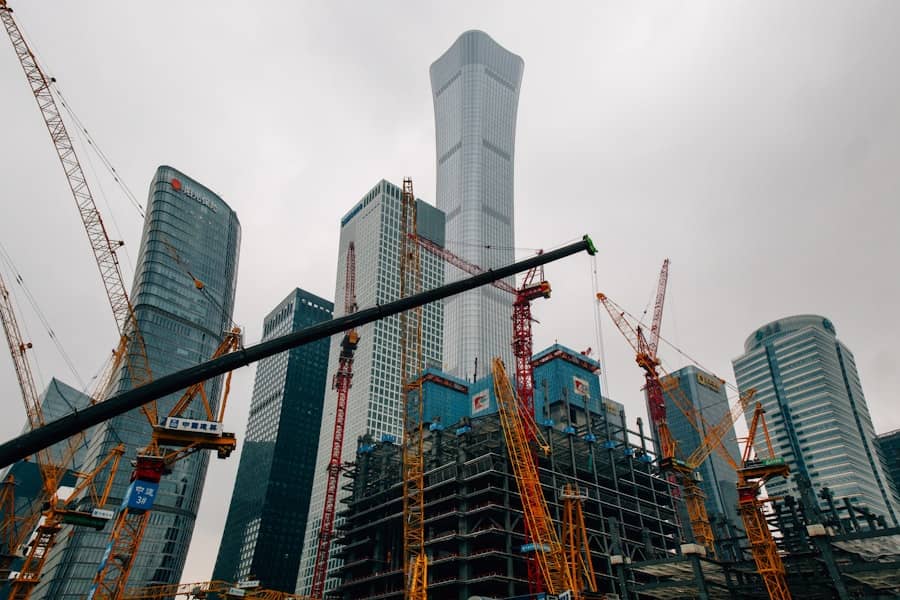
Understanding Building Valuation for Property Investment
Building valuation is the process of determining the economic value of a building or property. It involves assessing the physical condition, location, and market demand for the property to arrive at an accurate estimate of its worth. Valuation is crucial for various purposes such as property investment, insurance, taxation, and financial reporting.
It helps property owners, investors, and stakeholders make informed decisions about buying, selling, or managing real estate assets. Building valuation takes into account both the tangible and intangible aspects of a property, including its structural integrity, amenities, and potential for future appreciation. Building valuation is a complex and multifaceted process that requires a deep understanding of real estate markets, construction methods, and economic factors.
It involves analyzing a wide range of data such as comparable sales, rental income, construction costs, and market trends. Valuers use various methods and techniques to arrive at an accurate estimate of a building’s value, taking into consideration both the current market conditions and the long-term potential of the property. Overall, building valuation is a critical aspect of real estate investment and management, as it provides a basis for making informed decisions and maximizing the return on investment.
Key Takeaways
- Building valuation is the process of determining the economic value of a building or property.
- Factors affecting building valuation include location, size, condition, age, and market demand.
- Building valuation is important in property investment as it helps investors make informed decisions and maximize returns.
- Methods of building valuation include cost approach, sales comparison approach, and income approach.
- A building surveyor plays a crucial role in building valuation by assessing the condition and quality of the building.
Factors Affecting Building Valuation
Location, Location, Location
The location of a building is one of the most significant factors affecting its valuation. Properties in prime locations with good access to amenities, transportation, and employment opportunities tend to command higher values due to their desirability and potential for appreciation.
Physical Characteristics
The size and layout of a building also play a crucial role in its valuation, as larger and more functional spaces are generally more valuable than smaller or poorly designed ones. The condition and age of a building are important considerations in valuation, as well-maintained and modern properties are likely to be valued higher than older or poorly maintained ones. The quality of construction and materials used in the building also impact its value, as well-built and durable structures are more desirable to buyers and tenants.
Economic and External Factors
Economic factors such as interest rates, inflation, and market demand can also influence building valuation, as they affect the cost of financing and the overall demand for real estate. Additionally, zoning regulations, environmental factors, and legal restrictions can impact the value of a building by limiting its potential uses or development opportunities.
Importance of Building Valuation in Property Investment

Building valuation is crucial for property investment as it provides investors with a clear understanding of the potential return on investment and the risks associated with a particular property. By accurately valuing a building, investors can make informed decisions about purchasing, selling, or developing real estate assets. Valuation helps investors identify undervalued properties with potential for appreciation and assess the financial feasibility of their investment strategies.
It also provides a basis for negotiating purchase prices, securing financing, and managing the overall risk exposure of an investment portfolio. Furthermore, building valuation is essential for determining the insurance coverage and tax liabilities associated with a property. Accurate valuation ensures that properties are adequately insured against potential risks such as fire, natural disasters, or liability claims.
It also helps property owners comply with tax regulations and accurately report the value of their assets for tax purposes. Overall, building valuation is a fundamental aspect of property investment that provides investors with the necessary information to make sound financial decisions and maximize the return on their investment.
Methods of Building Valuation
| Method | Description |
|---|---|
| Comparable Sales Method | This method compares the property being valued to similar properties that have recently sold in the same area. |
| Income Approach Method | This method estimates the value of a property based on the income it generates, often used for commercial properties. |
| Cost Approach Method | This method calculates the value of a property by considering the cost of replacing it with a similar one, adjusted for depreciation. |
| Residual Method | This method is commonly used in property development to estimate the value of the land based on the future income it can generate. |
There are several methods used to value buildings, each with its own strengths and limitations. The most common methods include the sales comparison approach, income approach, and cost approach. The sales comparison approach involves comparing the subject property to similar properties that have recently sold in the same market.
This method is based on the principle of substitution, which assumes that buyers would not pay more for a property than they would for a comparable alternative. The income approach is used to value income-generating properties such as rental apartments or commercial buildings. It involves estimating the present value of future income streams generated by the property using techniques such as capitalization or discounted cash flow analysis.
The cost approach is based on the principle of replacement cost, which assumes that a buyer would not pay more for a property than it would cost to build an equivalent substitute. This method involves estimating the cost of replacing the building with a similar one at current construction prices, taking into account depreciation and obsolescence. Additionally, valuers may use a combination of these methods or other specialized techniques depending on the specific characteristics of the property and the prevailing market conditions.
Overall, building valuation methods aim to provide an accurate estimate of a property’s worth by considering its income potential, replacement cost, and market comparables.
The Role of a Building Surveyor in Valuation
Building surveyors play a crucial role in building valuation by providing expert advice on the physical condition and characteristics of a property. They conduct detailed inspections of buildings to assess their structural integrity, maintenance needs, and compliance with building codes and regulations. Surveyors also provide valuable insights into the potential risks and liabilities associated with a property, such as environmental hazards, safety concerns, or legal restrictions.
Their expertise helps valuers make informed decisions about the condition and suitability of a building for its intended use. Surveyors also contribute to building valuation by providing accurate measurements and documentation of a property’s physical attributes, such as floor area, layout, and amenities. This information is essential for determining the replacement cost and market comparables used in valuation methods such as the cost approach and sales comparison approach.
Additionally, surveyors may provide specialized services such as environmental assessments, energy efficiency audits, or feasibility studies to further inform the valuation process. Overall, building surveyors play a critical role in building valuation by providing comprehensive insights into the physical condition and characteristics of properties.
Common Mistakes in Building Valuation
Reliance on Outdated or Inaccurate Data
One common mistake is relying too heavily on outdated or inaccurate data when assessing market comparables or construction costs. This can result in overestimating or underestimating a property’s value, leading to potential financial losses or missed opportunities for investors.
Omitting Important Factors and Using Inappropriate Valuation Methods
Another common mistake is overlooking important factors such as environmental risks, legal restrictions, or maintenance needs that can impact a property’s long-term value. Valuers may also make mistakes by using inappropriate valuation methods or failing to consider the unique characteristics of a property when estimating its worth. For example, using the sales comparison approach for income-generating properties or failing to account for depreciation in the cost approach can lead to inaccurate valuations.
Subjective Biases and External Pressures
Additionally, valuers may be influenced by subjective biases or external pressures when determining a property’s value, leading to conflicts of interest or ethical concerns. Overall, avoiding these common mistakes requires valuers to conduct thorough research, use reliable data sources, and apply sound judgment based on their expertise and professional standards.
Tips for Maximizing Building Valuation for Property Investment
Maximizing building valuation for property investment requires careful planning, due diligence, and strategic decision-making. Investors can enhance the value of their properties by focusing on factors such as location, design, maintenance, and market positioning. Investing in properties located in high-demand areas with strong growth potential can increase their long-term value and appeal to potential buyers or tenants.
Additionally, optimizing the design and functionality of buildings to meet modern standards and lifestyle preferences can enhance their desirability and marketability. Regular maintenance and upgrades can also contribute to maximizing building valuation by preserving the physical condition and aesthetic appeal of properties. This includes addressing issues such as structural repairs, energy efficiency improvements, landscaping enhancements, and interior renovations that can add value to a property.
Furthermore, effective marketing and positioning strategies can help investors showcase the unique features and benefits of their properties to attract potential buyers or tenants willing to pay a premium price. Overall, maximizing building valuation for property investment requires proactive management and strategic investments that align with market trends and consumer preferences. In conclusion, building valuation is a critical aspect of real estate investment that involves assessing the economic value of properties based on their physical characteristics, market demand, and income potential.
Factors such as location, condition, size, economic conditions, and legal restrictions can influence building valuation. Accurate valuation is essential for making informed decisions about property investment, insurance coverage, tax compliance, and financial reporting. Various methods such as sales comparison approach, income approach, and cost approach are used to estimate building values based on market comparables, income potential, and replacement cost.
Building surveyors play a crucial role in providing expert advice on the physical condition and characteristics of properties to inform the valuation process. Common mistakes in building valuation include relying on outdated data, overlooking important factors, using inappropriate methods, and being influenced by biases or external pressures. Maximizing building valuation for property investment requires strategic investments in location, design, maintenance, marketing, and positioning that align with market trends and consumer preferences.
If you’re interested in learning more about building valuation, you should check out this article on housing markets that changed the most. It provides valuable insights into how different factors can impact the valuation of properties in various housing markets. Understanding these changes can be crucial for anyone involved in real estate investment or development.
FAQs
What is building valuation?
Building valuation is the process of determining the value of a building or property. This is typically done for various reasons such as buying or selling a property, obtaining a mortgage, insurance purposes, or for tax assessments.
How is building valuation determined?
Building valuation is determined by considering factors such as the location of the building, its size, age, condition, construction materials, and any improvements or renovations. Valuation can also be influenced by market trends and comparable sales in the area.
Who conducts building valuation?
Building valuation is typically conducted by professional appraisers or valuers who are trained and certified to assess the value of properties. These individuals use their expertise and knowledge of the real estate market to provide an accurate valuation.
Why is building valuation important?
Building valuation is important for both buyers and sellers as it helps determine a fair and accurate price for a property. It also plays a crucial role in securing financing, obtaining insurance, and ensuring that property taxes are assessed correctly.
Can building valuation change over time?
Yes, building valuation can change over time due to factors such as market fluctuations, changes in the condition of the building, renovations or improvements, and changes in the surrounding area. It’s important to periodically reassess the valuation of a property to ensure it remains accurate.

